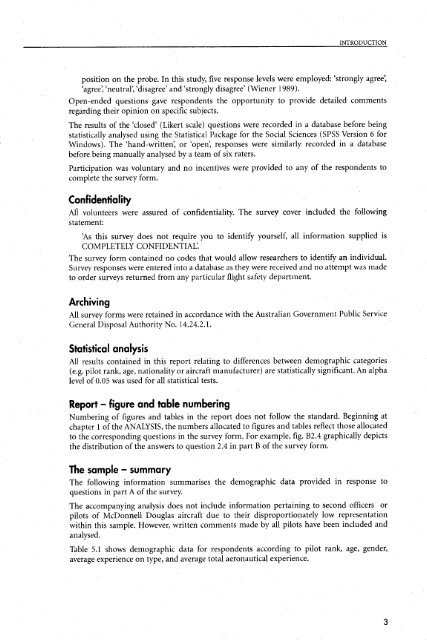Advanced Technology Aircraft Safety Survey Report - Australian ...
Advanced Technology Aircraft Safety Survey Report - Australian ...
Advanced Technology Aircraft Safety Survey Report - Australian ...
You also want an ePaper? Increase the reach of your titles
YUMPU automatically turns print PDFs into web optimized ePapers that Google loves.
INTRODUCTION<br />
position on the probe. In this study, five response levels were employed: ‘strongly agree’,<br />
‘agree’, ‘neutral’, ‘disagree’ and ‘strongly disagree’ (Wiener 1989).<br />
Open-ended questions gave respondents the opportunity to provide detailed comments<br />
regarding their opinion on specific subjects.<br />
The results of the ‘closed’ (Likert scale) questions were recorded in a database before being<br />
statistically analysed using the Statistical Package for the Social Sciences (SPSS Version 6 for<br />
Windows). The ‘hand-written’, or ‘open’, responses were similarly recorded in a database<br />
before being manually analysed by a team of six raters.<br />
Participation was voluntary and no incentives were provided to any of the respondents to<br />
complete the survey form.<br />
Confidentiality<br />
Ali volunteers were assured of confidentiality. The survey cover included the following<br />
statement:<br />
‘As this survey does not require you to identify yourself, all information supplied is<br />
COMPLETELY CONFIDENTIAL’.<br />
The survey form contained no codes that would allow researchers to identify an individual.<br />
<strong>Survey</strong> responses were entered into a database as they were received and no attempt was made<br />
to order surveys returned from any particular flight safety department.<br />
Arc hiving<br />
All survey forms were retained in accordance with the <strong>Australian</strong> Government Public Service<br />
General Disposal Authority No. 14.24.2.1.<br />
Statistical analysis<br />
All results contained in this report relating to differences between demographic categories<br />
(e.g. pilot rank, age, nationality or aircraft manufacturer) are statistically significant. An alpha<br />
level of 0.05 was used for all statistical tests.<br />
<strong>Report</strong> - figure and table numbering<br />
Numbering of figures and tables in the report does not follow the standard. Beginning at<br />
chapter 1 of the ANALYSIS, the numbers allocated to figures and tables reflect those allocated<br />
to the corresponding questions in the survey form. For example, fig. B2.4 graphically depicts<br />
the distribution of the answers to question 2.4 in part B of the survey form.<br />
The sample - summary<br />
The following information summarises the demographic data provided in response to<br />
questions in part A of the survey.<br />
The accompanying analysis does not include information pertaining to second officers or<br />
pilots of McDonnell Douglas aircraft due to their disproportionately low representation<br />
within this sample. However, written comments made by all pilots have been included and<br />
analysed.<br />
Table 5.1 shows demographic data for respondents according to pilot rank, age, gender,<br />
average experience on type, and average total aeronautical experience.<br />
3
















